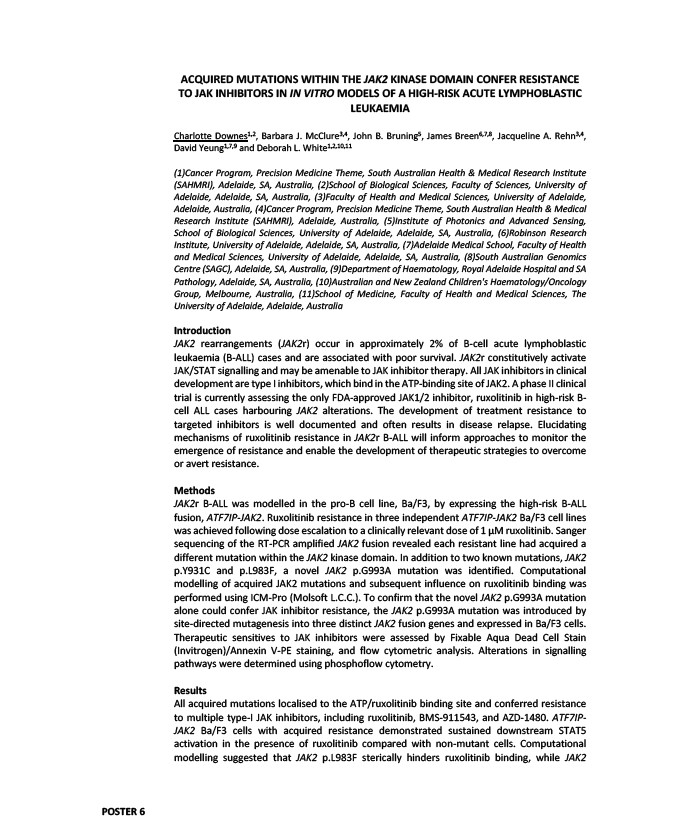
ACQUIRED MUTATIONS WITHIN THE JAK2 KINASE DOMAIN CONFER RESISTANCE
TO JAK INHIBITORS IN IN VITRO MODELS OF A HIGH-RISK ACUTE LYMPHOBLASTIC
LEUKAEMIA
Charlotte Downes1,2, Barbara J. McClure3,4, John B. Bruning5, James Breen6,7,8, Jacqueline A. Rehn3,4,
David Yeung1,7,9 and Deborah L. White1,2,10,11
(1)Cancer Program, Precision Medicine Theme, South Australian Health & Medical Research Institute
(SAHMRI), Adelaide, SA, Australia, (2)School of Biological Sciences, Faculty of Sciences, University of
Adelaide, Adelaide, SA, Australia, (3)Faculty of Health and Medical Sciences, University of Adelaide,
Adelaide, Australia, (4)Cancer Program, Precision Medicine Theme, South Australian Health & Medical
Research Institute (SAHMRI), Adelaide, Australia, (5)Institute of Photonics and Advanced Sensing,
School of Biological Sciences, University of Adelaide, Adelaide, SA, Australia, (6)Robinson Research
Institute, University of Adelaide, Adelaide, SA, Australia, (7)Adelaide Medical School, Faculty of Health
and Medical Sciences, University of Adelaide, Adelaide, SA, Australia, (8)South Australian Genomics
Centre (SAGC), Adelaide, SA, Australia, (9)Department of Haematology, Royal Adelaide Hospital and SA
Pathology, Adelaide, SA, Australia, (10)Australian and New Zealand Children's Haematology/Oncology
Group, Melbourne, Australia, (11)School of Medicine, Faculty of Health and Medical Sciences, The
University of Adelaide, Adelaide, Australia
I
ntroduction
JAK2 rearrangements (JAK2r) occur in approximately 2% of B-cell acute lymphoblastic
leukaemia (B-ALL) cases and are associated with poor survival. JAK2r constitutively activate
JAK/STAT signalling and may be amenable to JAK inhibitor therapy. All JAK inhibitors in clinical
development are type I inhibitors, which bind in the ATP-binding site of JAK2. A phase II clinical
trial is currently assessing the only FDA-approved JAK1/2 inhibitor, ruxolitinib in high-risk B-cell
ALL cases harbouring JAK2 alterations. The development of treatment resistance to
targeted inhibitors is well documented and often results in disease relapse. Elucidating
mechanisms of ruxolitinib resistance in JAK2r B-ALL will inform approaches to monitor the
emergence of resistance and enable the development of therapeutic strategies to overcome
or avert resistance.
Methods
JAK2r B-ALL was modelled in the pro-B cell line, Ba/F3, by expressing the high-risk B-ALL
fusion, ATF7IP-JAK2. Ruxolitinib resistance in three independent ATF7IP-JAK2 Ba/F3 cell lines
was achieved following dose escalation to a clinically relevant dose of 1 μM ruxolitinib. Sanger
sequencing of the RT-PCR amplified JAK2 fusion revealed each resistant line had acquired a
different mutation within the JAK2 kinase domain. In addition to two known mutations, JAK2
p.Y931C and p.L983F, a novel JAK2 p.G993A mutation was identified. Computational
modelling of acquired JAK2 mutations and subsequent influence on ruxolitinib binding was
performed using ICM-Pro (Molsoft L.C.C.). To confirm that the novel JAK2 p.G993A mutation
alone could confer JAK inhibitor resistance, the JAK2 p.G993A mutation was introduced by
site-directed mutagenesis into three distinct JAK2 fusion genes and expressed in Ba/F3 cells.
Therapeutic sensitives to JAK inhibitors were assessed by Fixable Aqua Dead Cell Stain
(Invitrogen)/Annexin V-PE staining, and flow cytometric analysis. Alterations in signalling
pathways were determined using phosphoflow cytometry.
Results
All acquired mutations localised to the ATP/ruxolitinib binding site and conferred resistance
to multiple type-I JAK inhibitors, including ruxolitinib, BMS-911543, and AZD-1480. ATF7IP-JAK2
Ba/F3 cells with acquired resistance demonstrated sustained downstream STAT5
activation in the presence of ruxolitinib compared with non-mutant cells. Computational
modelling suggested that JAK2 p.L983F sterically hinders ruxolitinib binding, while JAK2
POSTER 6